
When it comes to the Stairmaster muscles worked primarily involve those in the lower body, but there’s actually several stair stepping variations that work the upper body and transform this exercise into a full-body workout!1
Below we reveal each muscle worked, their role in stair stepping, the countless benefits of the Stairmaster, a workout program and before and after pictures of others who transformed their body with this one exercise alone.
And for those wondering how the stair master vs treadmill compare, we’ll also touch on the amount of calories burned with each alongside a calories burned calculator, and which one is a better cardio machine overall so you can choose the machine that’s best for your goals.
Stairmaster Muscles Worked: Which Muscles Are Targeted by the Stair Stepper?
The stair stepper, or otherwise known as the stair stepper machine or the Stairmaster, is a type of cardio involving exercise equipment that simulates the act of climbing stairs. There are man
Stairmaster
y muscles that this exercise will target, including the muscles of the lower body, core, and even the upper body depending on the exercises incorporated and hand positions used.
Overall, the stair stepper is a great way to get a complete, full body workout. Check out the detailed list of the Stairmaster muscles worked below for a comprehensive insight.
The Butt Muscles (Gluteus Maximus, Medius, & Minimus)
When it comes to the question of which muscles are worked by a Stairmaster, the answer that most immediately comes to mind would be the muscles of the buttocks or “glutes.” This consists of the gluteus maximus, gluteus medius, and gluteus minimus.
The stair stepper will help to build all three of these gluteal muscles, helping to target muscle growth and strength in the buttocks.
Don’t worry, the stair stepper won’t create a bulky look. Because it will also help to burn fat, the stair stepper will aid in creating a lifted and toned appearance.
For those wanting to gain muscle size, back squats are the go-to.
Maximus
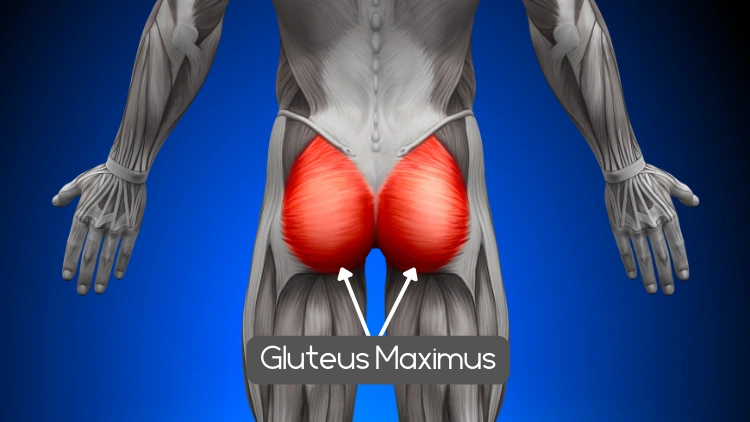
Source: decade3d via Canva.com2
Medius
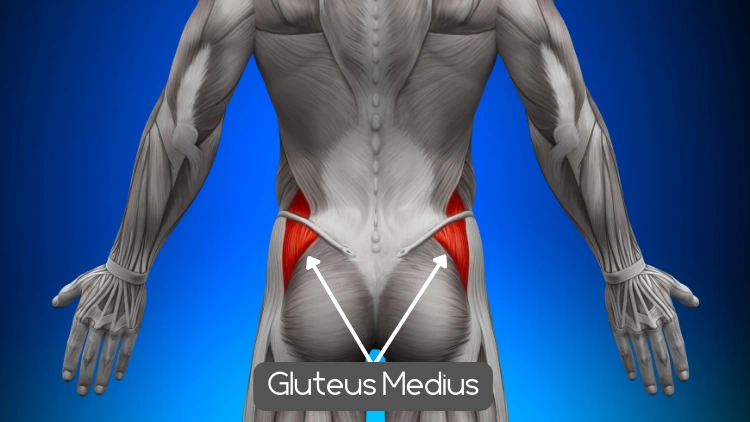
Source: decade3d via Canva.com3
Minimus
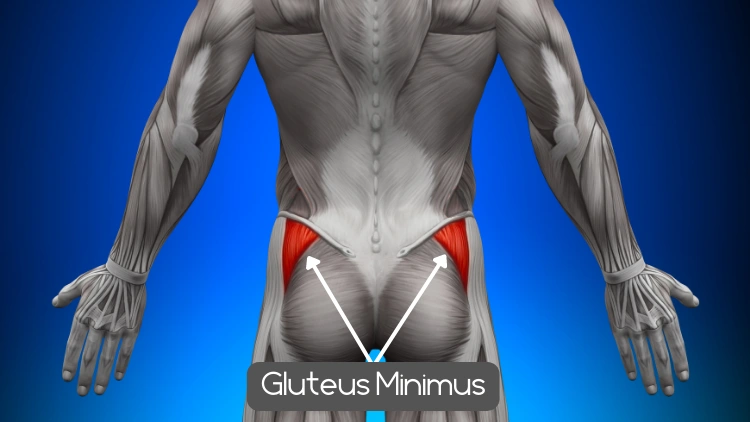
Source: decade3d via Canva.com3
The Quads (Quadriceps)
In addition to targeting all three gluteal muscles detailed above, the Stairmaster will also hit the quadriceps or otherwise known as “quads”. These are located on the front side of the thigh.
The quads are responsible for leg extension, so when a person straightens their leg to lift their body upwards on the stair stepper, they are engaging this muscle.
Quadriceps
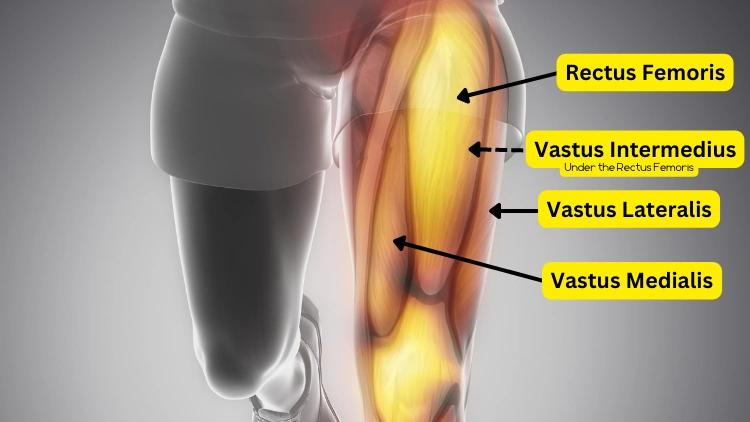
Source: janulla via Canva.com4
The Hammies (Hamstrings)
The hamstrings or “hammies” are the muscle that is found on the back side of the thigh. They are the counterpart to the quads discussed above, and are required for knee flexion.
The hammies are constantly engaged on the stair stepper as the person climbs each step although they play a minor role and likely won’t be sore after stair stepping.
Studies have shown that more muscle activation of the hamstrings increase with load, so steppers wanting to hit this muscle group should up the intensity for a hamstring workout.5
Hamstrings
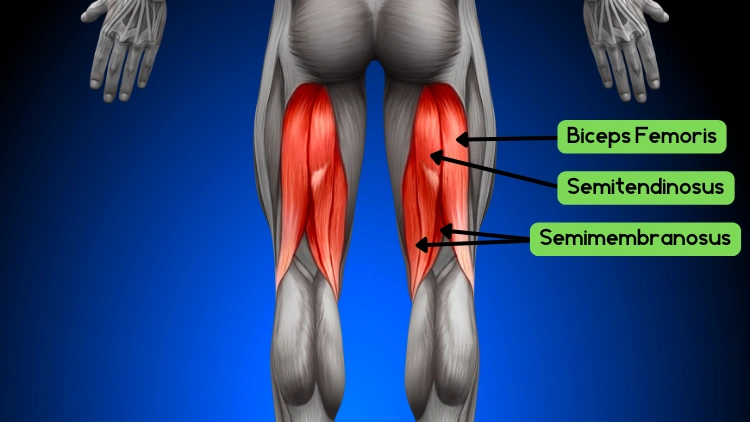
Source: decade3d via Canva.com6
The Calves (Gastrocnemius & Soleus)
The muscles of the calves include the gastrocnemius and soleus. They can be difficult to build, but through the constant engagement that the Stairmaster provides, this muscle is easily targeted to create more strength and leanness.
Gastrocnemius
Soleus
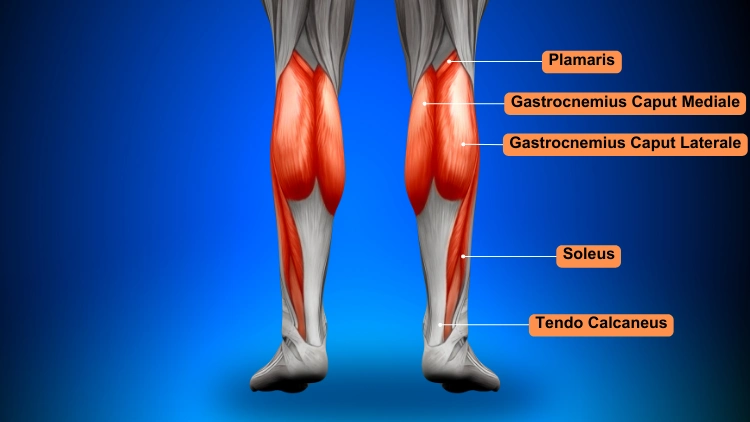
Source: decade3d via Canva.com7
The Core (Abdominals)
The Stairmaster will engage the core muscles or the abdominals because an upright position must be maintained while doing this exercise. Because the Stairmaster aids in fat burning and engages the muscle, this will lead to the stomach having more visible abs and an overall toned appearance with consistent work.
Abdominals
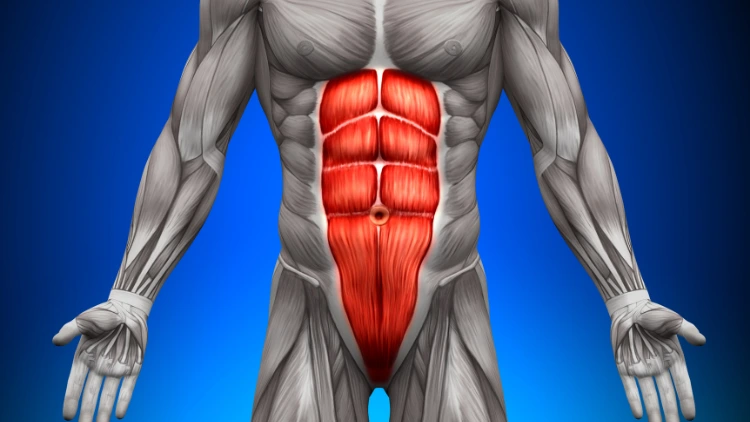
Source: decade3d via Canva.com8
Of course, the back muscles such as lats, rhomboids and traps may play a minor role too in stabilizing the trunk and the chest, shoulders, and arm muscles may also have a supporting role in gripping the handles on the side and/or with variations.
Muscles Than Can Be Worked With Stairmaster or Stair Stepper Variations
The stair stepper can also be used in combination with dumbbells or with various variations like the side step so some additional muscles can also be worked.
The Back Muscles (Latissimus Dorsi)
The back muscles are also engaged during the Stairmaster to maintain that correct posture. This will primarily consist of the “lats” as well as other deep muscles in the back.
Additionally, some stair stepping workouts can include back targeting workouts to hit this muscle group.
Lats
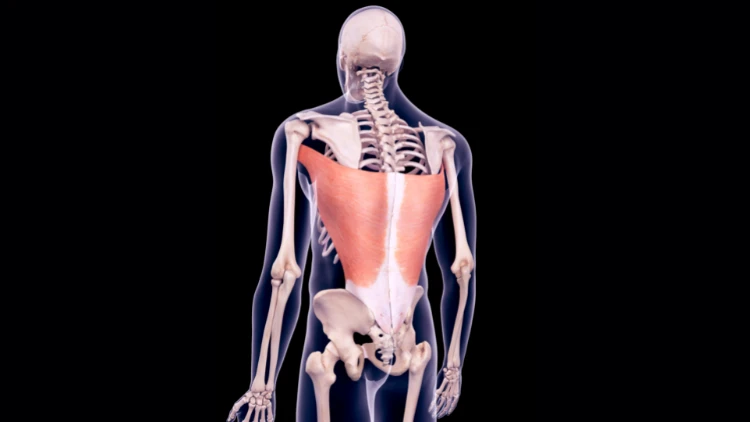
Source: Science Photo Library via Canva.com9
The Pecs (Pectorals)
The Stairmaster works mostly on the lower body and core, but the chest muscles known as the “pecs” can also be engaged through the use of upper body exercise during stair climbing. This may be achieved by using a light bar to complete chest presses or dumbbells to complete flys while using the stair stepper.
Pecs
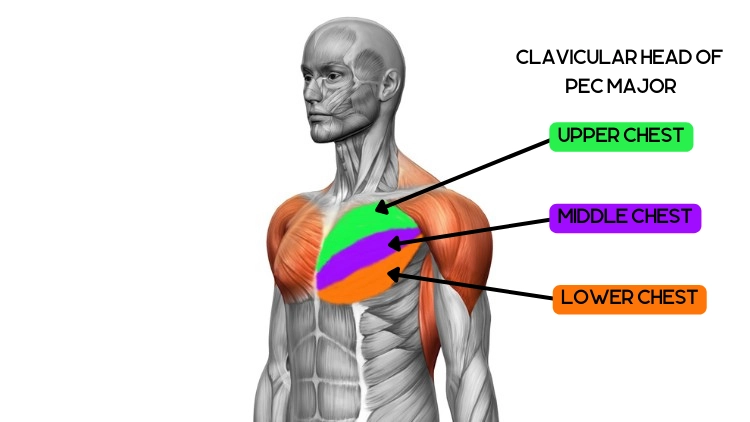
Source: Science Photo Library via Canva.com10
The Delts (Deltoids)
The shoulder muscles, or “delts,” are among the muscle groups engaged when using a Stairmaster and can also be targeted through the use of dumbbells or upper arm exercise movements while on the stair stepper. Try frontwards, backwards, or lateral arm raises with a light weight to hit each deltoid muscle striation.
Delts
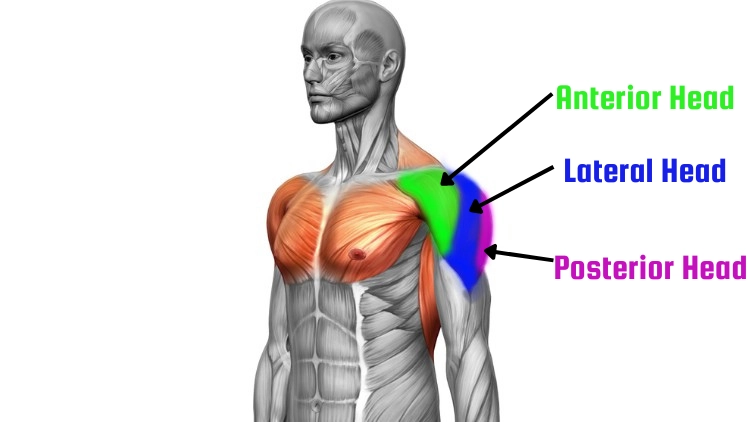
Source: Science Photo Library via Canva.com10
The Bis and Tris (Biceps and Triceps of the Upper Arm)
Just as the other upper body muscles can be targeted through exercise on the stairmaster, so can the arms. Try using a light dumbbell or bar to complete bicep curls or tricep extensions while climbing steps to help build and tone these muscle groups.
Biceps
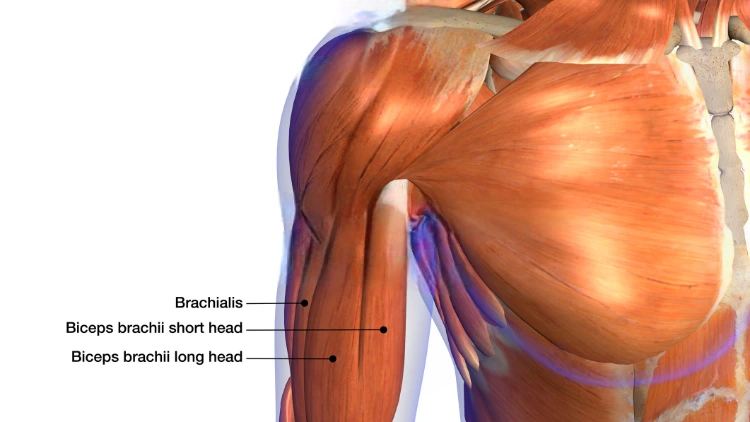
Source: Hank Grebe via Canva.com11
Triceps
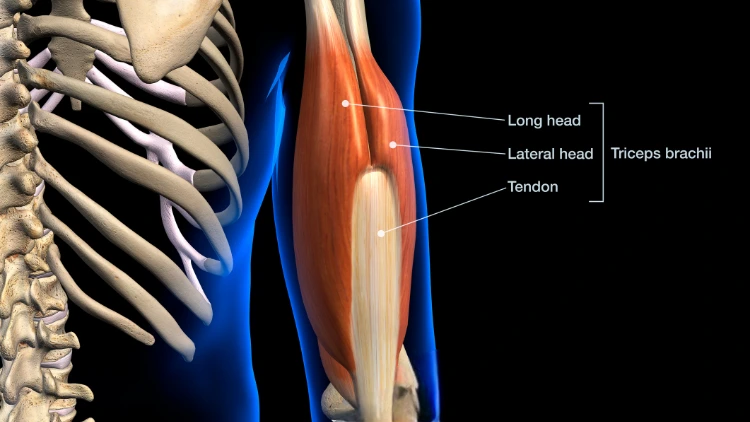
Source: Hank Grebe via Canva.com12
Abductors & Adductors
The abductors are responsible for moving the leg away from the body and is located above the glutes on the hip. While the adductors bring the leg towards the body and together and are located on the inner thigh.
So when a person walks up a Stairmaster sideways, their abductors are at work in the stepping up portion, and the adductors are engaged when their bottom foot is brought up to the next step.
This variation will be covered below alongside a video.
Stairmaster Benefits & Stair Running Benefits
In addition to targeting all the muscles detailed above, the Stairmaster has a number of great benefits that aids in a person’s overall fitness and health! Below is a complete list of the pros of starting a Stairmaster routine.
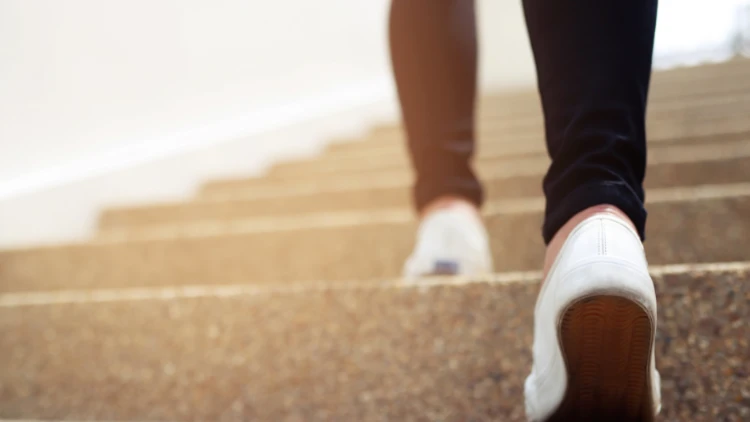
Source: rattanakun via Canva.com13
Remember, because the Stairmaster provides repetitive stairs to climb it offers a considerable amount more of cardiovascular engagement than just taking the steps on flat ground!
Cardiovascular Fitness
Stair climbing is an effective way to help improve a person’s overall cardiovascular fitness. This is achieved through raising the heart rate and increasing blood flow to the muscles of the body.
In fact, studies report that stair climbing can increase a person’s aerobic abilities.14 This creates a healthy challenge for the heart, allowing the heart muscle to become stronger and healthier.
Muscle Endurance
The discussion above about the muscles worked by the Stairmaster highlights all the muscle groups engaged in this exercise. As a result, a stair stepper can expect to see increases in muscle endurance for all targeted areas.
Because of the low weight, repetitions involved in this exercise, the stair stepper will result in helping the muscles to appear more lean.
Burning Calories
Compared to walking on the treadmill, the stair stepper burns significantly more calories. One study found walking to burn roughly 60 calories over a 15 minute time period.15
Alternatively, another study approximates that stair stepping burns 128 calories in the same time frame, making it the superior choice for burning calories due to its higher intensity.16
This translates in assisting in weight and fat loss, which improves the overall health of a person by decreasing the risk of a number of diseases. Furthermore, those consistently stepping can develop a more toned appearance as their body fat decreases by making their muscles more visible.
Balance
Stair climbing is a dynamic exercise, and therefore requires the activation of a person’s coordination and balance skills. Overtime with consistent use of a stair stepper routine, a dieter will likely see improvements in these areas.
Is the Stairmaster an Effective Cardio Workout?
The Stairmaster is great for fitness enthusiasts who want to mix up their cardio routine! It’s an ideal exercise that can help to improve a person’s overall cardiovascular fitness, resulting in calories burned and a strengthened heart and lungs.17
The level of difficulty can be adjusted, varying from low to high intensity making it a good cardio choice for beginners and more advanced lifters alike.
Some machines that use revolving stairs will have varying speed options to help make a workout more challenging, while other steppers have an adjustable resistance that can further target the glutes, thighs, and calves. Steppers can even add a weighted vest to their routine to provide the best workout possible.
Because the Stairmaster is low impact, it’s also the perfect routine for those who struggle with joint pain or have had previous injuries such as ACL tears. There are additional strengthening exercises and stretching for knee pain treatment that can be used with a Stairmaster routine.
All in all, the Stairmaster is a great cardio routine to try for every type of fitness person out there.
Does the Stairmaster Build Muscle or Good for Toning?
The Stairmaster muscles worked includes the engagement of the whole body, and as a result, means that all the muscles involved are being somewhat built. By using a stair stepper, a person should expect to see improvements in muscular endurance.
Beginners who are new to working out might also find themselves gaining strength too.
But don’t worry, the Stairmaster won’t lead to a bulky appearance or significant amounts of muscle being put on. If muscle growth is the goal, a lifter should consider using a weighted routine such as a 5 day powerbuilding split instead.
Because the Stairmaster engages the muscles while also aiding in weight loss, this means that it’s a great way to improve overall muscle tone. By combining these two factors, the muscles will be more apparent, creating an overall lean looking physique.
Benefits of Using Treadmill vs Stairmaster
The benefits of using a treadmill are very similar to the benefits of using a Stairmaster. In general, the treadmill can be a great tool to help a person to improve their overall cardiovascular fitness, burn more calories, lose weight and shed hard to burn fat.
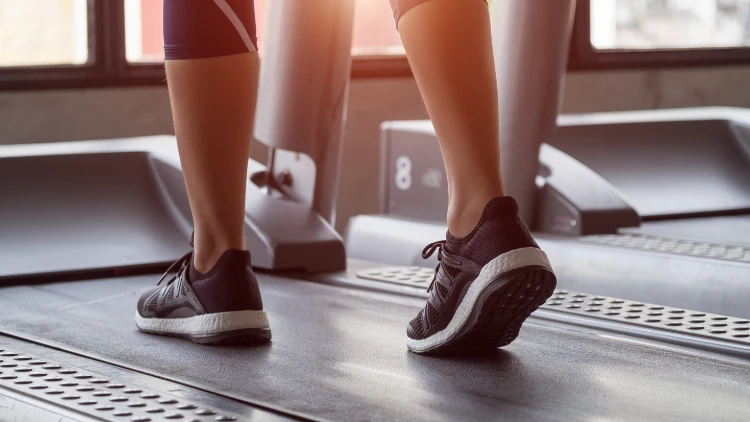
Source: kanchanachitkhamma via Canva.com18
It’s also a very versatile machine, that can be adjusted to simulate running hills, allow for low impact walking, or even high intensity sprints.
To elaborate, let’s take a look at the full picture:
Main Benefit of Stairmaster: Cardiovascular improvement, weight loss and fat loss, lower body and core strength and toning, increased balance and coordination, low impact.
Main Benefits of Treadmill: Cardiovascular improvement, weight loss and fat loss, lower body and core strength and toning, versatility in workout factors, available at most gyms.
The main benefit of the treadmill more so than the Stairmaster in this case is the ability of doing highly intense sprints to help target a person’s anaerobic fitness, or cardio that does not require oxygen to transfer stored carbs into energy. But the Stairmaster still allows for intense workout through the adjustment of speed and resistance.
A Comparison of Stair Stepper vs Treadmill
Both the stair stepper and treadmill are popular pieces of cardiovascular equipment that help to provide a range of health benefits to the person completing them. In fact, studies have shown that both machines result in similar performance results.19
Readers are encouraged to check out the side by side comparison below for a full picture of the benefits of both of these machines.
Ultimately, the choice between the Stairmaster and treadmill will depend on a person’s fitness goals and personal preferences.
Stairmaster vs Treadmill as Cardio Machines
Cardio is an aerobic type of exercise that simply means oxygen is required to help break down stored energy in the body. This form really engages the heart and lungs for overall health and fitness improvements.
And when it comes to cardio, both the treadmill and Stairmaster are great forms of exercise that will improve cardiovascular fitness. Choosing one over the other comes down to personal preference.
How Many Calories Are Burned on a Stair Stepper vs. a Treadmill
When it comes to calculating how many calories are burned, simply use the following equation to compare treadmill walking and running vs stair stepping. These equations use the activities MET values, which is a numerical value based on the amount of energy used during a task.
The MET value for the Stairmaster is 6, while the MET value for walking briskly is 4, and running at 6 miles per hour is 10.20
(MET Value of Activity) x Body Weight (kilograms) x time (hours) = Calories burned
To convert body weight into kilograms, take the weight in pounds and divide that number by 2.2. Here is what the equation will look like:
Body Weight (pounds) / 2.2 = Body Weight (kilograms)
For example, a person weighing 140 lbs and working out for one hour would burn approximately 636 calories running, 252 calories walking, and 382 calories on the Stairmaster.
Stair Stepper Calories Burned Calculator
Simply put in how long you intend to workout and your weight to see an estimation of how many calories you’ll burn using the a stair stepper!
Treadmill Calories Burned Calculator
Since the MET is known, we can check how many calories a brisk walk on the treadmill will burn too:
Stairmaster Muscles Worked vs Treadmill Muscles Worked
All in all, the Stairmaster and treadmill work the same muscles, but for clarity, here’s the muscles worked on each.
The Stairmaster targets the following muscles:
- Glutes
- Quads
- Hamstrings
- Calves
- Core
- Upperbody (depending on the exercises incorporated)
The treadmill with engage the following:
- Glutes
- Quads
- Hamstrings
- Calves
- Core
- Upper body (depending on the exercises incorporated)
It’s important to keep in mind that while the muscles are similar, some target muscles more than others.
For example, the stair stepper has variations that really engage the glutes more than a treadmill can. While the treadmill might have higher incline settings that can better target the calf muscles. Ultimately, it’s all about the settings that an individual person utilizes.
Stair Stepper Before & After Results With Pictures
There are many Stairmaster muscles worked, and that can be proven by some of the incredible before and after stair stepper workout results. Below includes personal testimonies along with before and after comparisons of people who have successfully integrated the Stairmaster into their routine.
Keep in mind that a stair stepper is not needed to make healthy changes! In fact, research suggests that exercise can help with weight loss.20 This might include lifting weights, running, or of course the Stairmaster; all of which can aid in amazing transformations.
Terran
Terran had an incredible Stairmaster transformation in only seven days! She set a challenge for herself to complete one thousand Stairmaster steps per day, and documented her progress on her YouTube channel with a goal to inspire others to obtain their dream body too.
Terran makes note that while this challenge got results, it was not a sustainable workout to do everyday for the long term. So those wanting to add a stair step routine should keep in mind the importance of getting adequate rest days to not overwork their muscles.
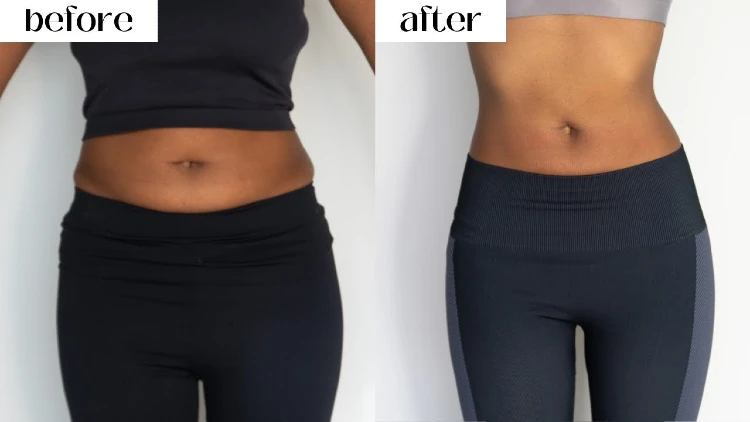
7 days, 1000 steps a day, and a stunning transformation. Source: Terran Dailey on Youtube21
Elizabeth
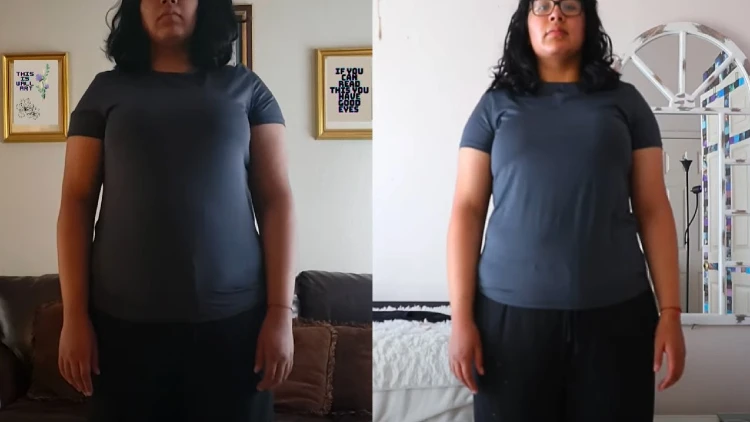
Elizabeth’s Stairmaster challenge proves that dedication and consistency can lead to improved endurance, better health, and weight loss. Source: subjectofmymind on Youtube22
Elizabeth engaged in a 30 day weight loss challenge in which she completed one hour on the stair stepper for 30 days straight. She said this routine was realistic for her and others like her to complete, and she found fantastic results from her hard work.
Overall, she found that the Stairmaster challenge helped to improve her overall endurance and health, and also led to weight loss too!
Top Stair Stepper Workout Plans
The following stair stepper programs can be done as often as desired, but steppers should keep in mind that proper rest days are required in order for the body to recover. According to research, a day of rest is required after day three of consecutive exercise to prevent fatigue.23 They can easily fit into a 4 day workout split routine.
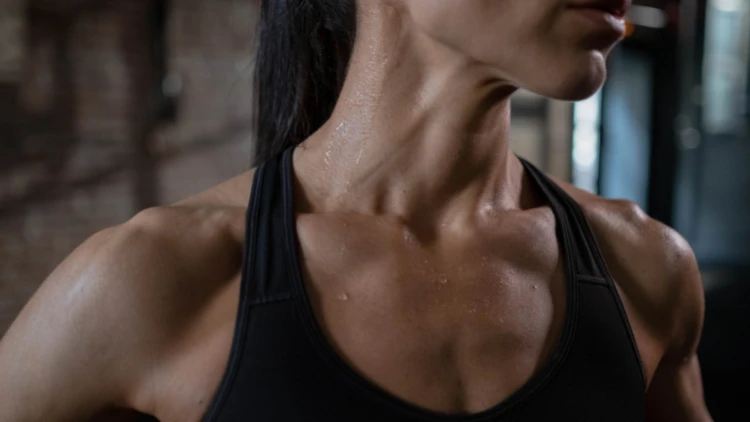
Source: cottonbro via Canva.com24
The following workouts can simply be used by following the instructors during the length of the video. Or, they can be personally tailored to an individual’s fitness level by increasing or decreasing the intensity or speed settings.
HIIT Stair Stepping To Target the Glutes
This is a highly intense routine that is great for targeting the lower body muscles, especially the glute muscles. This circuit program will be completed two to three times through to really target cardio.
Use two times a week for best results.
Make sure to include a two to three minute warm up at roughly level 8 to properly prepare the legs to workout. Afterwards, each exercise will be completed for one minute each before moving onto the next.
This will include side stepping for one minute per leg, low squat stepping, single steps, and stair running at a challenging speed. Always take a short cool down afterwards.
Quick Biceps, Traps & Delts Stair Routine
All that one needs for this program is a stair stepper and dumbbells. Along with the lower body, this workout will hit the biceps, traps, and delts to help make the whole body more toned.
Complete the circuit two to three times in total, and use it at least twice per week. Like the workout above, each exercise is completed for one minute.
This workout will include a short warm up, followed by single shoulder presses one minute per arm, single arm upright rows while sidestepping, single arm bicep curls while sidestepping, glute kickbacks with double step, and double steps.
Stairmaster Variations
Becoming narrow minded is one of the 8 deadly training sins and to combat this, try adding a workout variation. There are many different Stairmaster variations that a person can try to target different muscle activation.
Below is a list to help those who are just starting out or are looking for ideas to add more variety to their workout. Don’t be afraid to try something new to maximize results!
- Stairmaster Kickback: With each step, simply kick back the leg to help emphasize the glutes or butt muscles. This will really help to tone the buttocks as this variation is very glute dominant.
- Stairmaster Calf Raise: Instead of walking flat footed, a person can remain on their toes for each step. This emphasizes the calf muscles, which is perhaps the hardest muscle to grow.
- Banded Stairmaster Climb: To do this variation, simply attach a band around the thigh muscles. That way, resistance is added during each and every step of the stair stepper. This is especially great for hitting the quads.
- Double Step: The double step can be a brutal Stairmaster workout! To try this type of Stairmaster movement, simply step up two stairs at a time. This is great for the entire lower body, but specifically is a glutes and hamstring dominant variation.
- Sideways Step: This one is a great variation to add to help engage the hip abductors, or the muscle that is responsible for the lateral or sideways step movement. Keep in mind that the sideways step can be tricky, so steppers should practice this fancy footwork on a lower setting before using this variation.
- Stair Running: This can be achieved from running up flights of regular stairs, or increasing the speed on the stairmaster. It’s a great variation to up the intensity or a workout to maximize cardiovascular fitness.
Note, some of these modifications work more muscles than the ones listed but that’s because a huge modification is added. For example, the sideways step works the abductors (muscle that moves the leg away from the body) some as well.
How To Use the Stairmaster for the Best Results
When it comes to how to use stair stepper to maximize results, the directions will vary from person to person depending on their overall fitness goal. But as overall directions go, a person should make sure to keep their hands on their hips if not engaging in an exercise, while keeping their core tight with upright posture.
Try a HIIT Workout
If a person is wanting to build their muscle size and strength as much as possible, then using a high intensity interval training or HIIT Stairmaster routine is ideal. Research has shown that HIIT workouts help to produce muscular hypertrophy, or more simply put, muscular growth and strength.25
To complete a HIIT workout, try doing 20 seconds of a high resistance or speed setting, followed by 40 seconds of a rest break at a low intensity setting. This should be completed a minimum of x8 sets, but keep in mind that the number of sets, length ratio, and intensity settings can all be adjusted to appropriately meet the stepper’s fitness level.
Do a Weight Lifting Program in Addition to Stair Stepping
In addition to a HIIT program, a person who wants to maximize muscle size may also benefit from using a beginner hypertrophy program in conjunction with the Stairmaster. For this specific program, a lifter will workout 3x per week for four weeks. Stair stepping can make a great warm up for the lower body, could be used to improve endurance after a workout, or can be completed on non-lifting days to solely focus on cardiovascular fitness.
Use Stair Stepping for Weight Loss
If a stepper is wanting weight loss solutions, then longer intervals with lower intensity might be the best type of routine to see the results they desire. In this example, a person could use the stair stepper for 40 minutes, four days a week to help burn the amount of calories they desire.
Eat Healthier or Count Calories
A healthy diet that is high in protein helps to build muscle, drop fat, and shed pounds. Dieters may benefit from utilizing protein shakes diet plans to help achieve their fitness goals.
Make sure to also include lots of fruits and vegetables to maximize nutrition.
If weight loss is the goal, a stepper may benefit from counting calories to maximize the caloric deficit, or the amount of calories that are burned versus the amount that are consumed. This can help a dieter to hit their weight goals.
Alternatively, a dieter can use other weight loss strategies such as intuitive eating, fasting, or the one meal a day diet.
Include Variations
Varying a workout can help target different muscle groups for maximized results. Using any of the movements discussed above will help to hit the various muscles of the legs for a complete workout.
Stairmaster variations can also include using light weights to target the upper body. Some exercises to try include bicep curls, tricep extensions, shrugs, and shoulder raises.
Stay Consistent
To truly get the best results, it’s important for a stepper to stay consistent. Remember results do not happen overnight!
So choose a feasible routine that can be completed over the course of several months for best results.
Try planning a daily routine that allows at least 30 minutes of stair climbing per day. This will help a person to form habits to stay consistent and ensures there is enough time set aside every day to work on one’s health.
Don’t worry, not every day has to be an intense stepping workout! In fact, a person’s off day could include low intensity walking or stretching. This helps to solidify a healthy routine to maximize consistently, while also providing enough rest to prevent injury or fatigue.
Ultimately, there are many stair stepper workouts to choose from as well as the benefits of stair stepping in comparison to the more traditional treadmill cardio workout. In addition to understanding this fact, readers have also learned the Stairmaster muscles worked in order to obtain a full body workout and achieve their fitness related aspirations.
Frequently Asked Questions
Which Is Better: Stair Stepper vs Treadmill?
Neither the stair stepper or treadmill is considered better or worse, they’re just different! Both have their benefits and should be personally selected by a person depending on their overall fitness goals.
Does Stair Climber Burn Fat?
Yes, the stair climber is a great tool for burning hard to lose fat because of the amount of energy that it requires the body to use. Furthermore, cardiovascular exercise such as the stairmaster will aid in boosting a person’s metabolism leading to more calories burnt and more fat lost.
How Often Should You Use the Stairmaster?
This is a tricky question, because it truly depends on the individual and their overall fitness goals. Those completing low intensity cardio workouts can incorporate the stairmaster into their routine most days of the week while those doing highly intense stair climber workouts will require more rest days for muscle recovery and injury prevention.
How Long Should I Use the Stairmaster?
Similar to the question above, the answer will vary depending on the fitness goals. Those wanting to maximize calories and fat burnt are better off doing longer intervals for 40 to 60 minutes while highly intense workouts can be shorter.
Why Should I Use the Treadmill for Cardio?
There are many reasons that a treadmill should be used for cardio over other cardio machines. One of the main reasons this machine is a good option is because of the low intensity cardio workout it can provide. This is ideal for people who have had previous injuries or joint pain, and can only tolerate a low impact cardio workout.
The treadmill is also ideal for those who are wanting to specifically target this running form and speed, which are two factors that cannot be focused on during a stair climber workout. This particularly comes in handy when a person is training for marathons or sprints and does not have access to outdoor resources.
Finally, sometimes the treadmill is all that is available. It’s a very popular, versatile machine that allows for great cardio. Therefore, a treadmill will likely be available at any gym location, while cardio equipment like the Stairmaster might not be.
References
1Piacquadio, Andrea. Canva. Accessed 20 April 2023. <https://www.canva.com/photos/MAD7G4PUn-o-young-female-athlete-training-alone-on-treadmill-in-modern-gym/>
2decade3d. Canva. Accessed 20 April 2023. <https://www.canva.com/photos/MADerAJvWMU-gluteus-maximus-anatomy-muscles/>
3decade3d. Canva. <https://www.canva.com/photos/MAC_U4VEw9o-glutes-medius-anatomy-muscles/>
4janulla. Canva. <https://www.canva.com/photos/MADE-Sq7uLk-quadriceps-female-anatomy/>
5Yali, H., Aiguo, S., Haitao, G., & Songqing, Z. (2015). The muscle activation patterns of lower limb during stair climbing at different backpack load. Acta of bioengineering and biomechanics, 17(4), 13–20. <https://pubmed.ncbi.nlm.nih.gov/26899302/>
6decade3d. Canva. Accessed 20 April 2023. <https://www.canva.com/photos/MADerMxdfBI-hamstrings-anatomy-muscles/>
7decade3d. Canva, <https://www.canva.com/photos/MAC_U2yFahk-calves-anatomy-muscles/>
8decade3d. Canva. Accessed 20 April 2023. <https://www.canva.com/photos/MADerFwn3js-abs-anatomy-muscles/>
9Science Photo Library. Canva, <https://www.canva.com/photos/MADq3vbyn-k-f017-1255/>
10cience Photo Library. Canva, <https://www.canva.com/photos/MADmTGwAFbo-the-muscles-involved-in-standing-biceps-curl-the-stabilizing-muscles-are-highlighted-/>
11Grebe, Hank. Canva, <https://www.canva.com/photos/MADZASGJL7w-labeled-anatomy-chart-of-neck-and-shoulder-muscles-on-white-background/>
12Grebe, Hank. Canva, <https://www.canva.com/photos/MAEJnzTxmJU-labeled-anatomy-chart-of-shoulder-elbow-and-triceps-muscles-in-skeleton-on-black-background/>
13rattanakun. Canva. Accessed 20 April 2023. <https://www.canva.com/photos/MAEJdVR6Nwg-woman-walking-up-the-stairs/>
14Hongu, N., Shimada, M., Miyake, R., Nakajima, Y., Nakajima, I., & Yoshitake, Y. (2019). Promoting Stair Climbing as an Exercise Routine among Healthy Older Adults Attending a Community-Based Physical Activity Program. Sports (Basel, Switzerland), 7(1), 23. <https://doi.org/10.3390/sports7010023>
15Creasy, S. A., Rogers, R. J., Byard, T. D., Kowalsky, R. J., & Jakicic, J. M. (2016). Energy Expenditure During Acute Periods of Sitting, Standing, and Walking. Journal of physical activity & health, 13(6), 573–578. <https://doi.org/10.1123/jpah.2015-0419>
16Halsey, L. G., Watkins, D. A., & Duggan, B. M. (2012). The energy expenditure of stair climbing one step and two steps at a time: estimations from measures of heart rate. PloS one, 7(12), e51213. <https://doi.org/10.1371/journal.pone.0051213>
17Kennedy, R. A., Boreham, C. A., Murphy, M. H., Young, I. S., & Mutrie, N. (2007). Evaluating the effects of a low volume stairclimbing programme on measures of health-related fitness in sedentary office workers. Journal of sports science & medicine, 6(4), 448–454. <https://www.ncbi.nlm.nih.gov/pmc/articles/PMC3794484/>
18kanchanachitkhamma. Canva. Accessed 20 April 2023. <https://www.canva.com/photos/MAEV6FCjTI4-close-up-of-person-using-treadmill/>
19Loy, S. F., Holland, G. J., Mutton, D. L., Snow, J., Vincent, W. J., Hoffmann, J. J., & Shaw, S. (1993). Effects of stair-climbing vs run training on treadmill and track running performance. Medicine and science in sports and exercise, 25(11), 1275–1278. <https://pubmed.ncbi.nlm.nih.gov/8289616/>
20Bellicha, A., van Baak, M. A., Battista, F., Beaulieu, K., Blundell, J. E., Busetto, L., Carraça, E. V., Dicker, D., Encantado, J., Ermolao, A., Farpour-Lambert, N., Pramono, A., Woodward, E., & Oppert, J. M. (2021). Effect of exercise training on weight loss, body composition changes, and weight maintenance in adults with overweight or obesity: An overview of 12 systematic reviews and 149 studies. Obesity reviews : an official journal of the International Association for the Study of Obesity, 22 Suppl 4(Suppl 4), e13256. <https://doi.org/10.1111/obr.13256>
21Terran Dailey. “1000 Stairmaster Steps EVERYDAY for a Week | Before and After.” YouTube, 27 October 2021, Accessed 31 March 2023. <https://www.youtube.com/watch?v=7tRrAByaJ3U>
22subjectofmymind. “REALISTIC results of doing the stairmaster EVERYDAY for 1 HOUR for 30 DAYS.” YouTube, 10 May 2017, Accessed 31 March 2023. <https://www.youtube.com/watch?v=g7Na4JkGYso&t=743s>
23Stewart, R. D., Duhamel, T. A., Rich, S., Tupling, A. R., & Green, H. J. (2008). Effects of consecutive days of exercise and recovery on muscle mechanical function. Medicine and science in sports and exercise, 40(2), 316–325. <https://doi.org/10.1249/mss.0b013e31815adf02>
24cottonbro. Canva. Accessed 20 April 2023 <https://www.canva.com/photos/MAEc8fsD1qs-close-up-view-of-a-woman-sweating/>
25Biglari, S., Afousi, A. G., Mafi, F., & Shabkhiz, F. (2020). High-intensity interval training-induced hypertrophy in gastrocnemius muscle via improved IGF-I/Akt/FoxO and myostatin/Smad signaling pathways in rats. Physiology international, 107(2), 220–230. <https://doi.org/10.1556/2060.2020.00020>